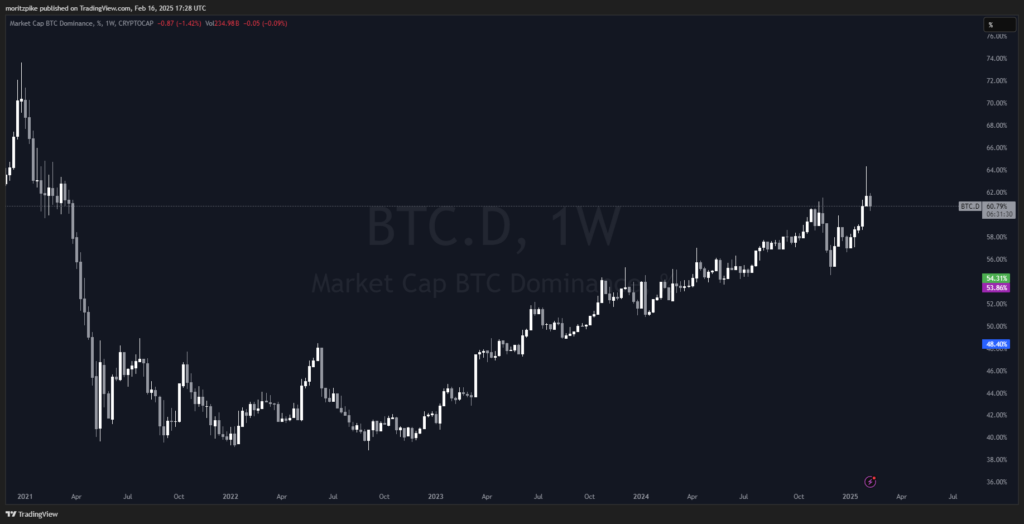Bitcoin’s market dominance (BTC.D) has quietly staged a remarkable comeback, climbing from a 2022 low of ~40% to ~61% today—its highest level since July 2021. This resurgence isn’t merely a cyclical blip; it reflects a deeper structural shift in crypto markets. As narratives around altcoins fracture under scrutiny and nation-states quietly accumulate BTC, the case for Bitcoin’s unstoppable dominance grows stronger. Here’s why this trend may only accelerate.

The Disappearing Bear Case for Bitcoin
Bitcoin’s critics once pointed to extreme volatility and speculative excess as existential risks. Today, those arguments feel increasingly outdated. With institutional adoption maturing (BlackRock’s IBIT holds ~$60 billion worth of Bitcoin at the time of this article; Bitcoin is sitting at a remarkable market cap of $1.9 trillion dollars – a Top 7 Asset worldwide) Bitcoin’s bear case has eroded. It’s no longer a “risky tech experiment”—it’s a macro asset with staying power. Meanwhile, parts of the altcoin market tells a different story.
The Altcoin Dilemma: Value Extraction vs. Value Creation
Altcoins face a brutal reality check. Projects often prioritize short-term profit over long-term utility, with recent data from Solana exemplifying this trend. According to @0xngmi on X, approximately $3.6-6.6 billion has been siphoned from Solana memecoin trading since 2024 through various mechanisms:
This systematic value extraction highlights a fundamental issue within the altcoin ecosystem. Tokens like $LIBRA (Argentina Coin) and various celebrity-linked “rug pulls” further underscore a market saturated with speculative churn rather than sustainable innovation.
The Solana Paradox
Even Solana — widely considered the “TradFi-friendly” chain due to its regulatory alignment and U.S. roots — faces existential challenges. While the network has successfully attracted significant user activity and institutional interest, this success has paradoxically exposed its vulnerabilities:
- Regulatory Scrutiny: Its high-profile status makes it a prime target for increased oversight
- User Trust: The prevalence of scams and value extraction threatens long-term adoption
- Market Risk: A potential correction of 70-80% could trigger broader concerns about the viability of alternative Layer 1 platforms
This situation exemplifies the broader challenge facing all alternative blockchains: how to balance rapid growth and user adoption with sustainable, legitimate value creation.
Institutional Flows vs. Retail Apathy
The divergence between Bitcoin and altcoins is stark in ETF flows. While Bitcoin ETFs attract steady institutional capital, Ethereum’s newly approved funds tell a revealing story: retail investors are largely absent. The bulk of ETH ETF activity comes from institutions with vested interests (e.g., market-making or hedging), not organic demand.
This aligns with patterns like Eric Trump’s curiously timed February 2025 tweet—“It’s a great time to add $ETH”—days before staking provisions were added to ETH ETF applications. Such insider-adjacent behavior fuels skepticism about altcoins’ decentralization ethos.
Nation-State Adoption: A Game-Theoretic Tipping Point
Bitcoin’s dominance isn’t just market-driven—it’s geopolitical. Consider:
- Abu Dhabi’s sovereign wealth fund disclosed $436M in Q1 2025 Bitcoin ETF buys last week.
- Discussions of a U.S. strategic Bitcoin reserve could trigger a domino effect: if one major power holds BTC, others must follow or risk monetary asymmetry.
- China is already building their bitcoin reserves through big mining farms since years.
- El Salvador and CAR recognize BTC as legal tender — currently not relevant in a bigger picture but still shows the potential of Bitcoin even for “third world countries”.
This creates a self-reinforcing cycle. As states accumulate Bitcoin, its scarcity intensifies, incentivizing further adoption—a classic game-theoretic equilibrium.
The Long Game: Navigating the New Crypto Hierarchy
Bitcoin’s dominance isn’t just a market trend—it’s a paradigm shift that redefines the hierarchy of crypto. Over the next decade, this recalibration will likely split the ecosystem into two distinct categories: Bitcoin and “the rest”.
Bitcoin is cementing itself as the crypto asset—a sovereign-grade store of value, a macro hedge, and the default gateway for institutional capital. Its scarcity, neutrality, and growing adoption by nation-states position it in a league of its own. The decisive factor is that it no longer competes with altcoins, and so is likely to outperform them.
This doesn’t spell doom for all altcoins. Projects with tangible utility, decentralized governance, and sustainable tokenomics could thrive—but they’ll battle for relevance in a smaller (market share wise), saturated market. Recent market movements illustrate this dynamic perfectly: while most altcoins struggle for attention, standout projects like $HYPE (Hyperliquid) have generated unprecedented wealth creation effects for average investors. These exceptional cases, however, only underscore the broader trend—success in the altcoin space increasingly demands genuine innovation and utility rather than mere speculative appeal.
Conclusion: The Casino and the Safe
The altcoin market remains a casino—a volatile, exhilarating space where insiders (exchanges, MEV bots, influencers) extract value while retail chases moonshots. Bitcoin, however, operates outside this paradigm. It isn’t part of the casino; it’s the safe where players store their winnings.
For investors, this demands a clear strategy:
- Bitcoin is the foundation: a hedge against monetary debasement, geopolitical instability, and systemic risk.
- Altcoins are optional satellites: high-risk bets on specific narratives or speculative plays, but no longer framed as “the next Bitcoin.”
The casino will keep running, but its stakes are changing. Meanwhile, Bitcoin’s dominance grows not through competition, but through irrelevance—to the noise.
TL;DR: eventually bitcoin will trade much higher, with less downside potential than in past cycles, but at the same time the available market share for altcoins could shrink over time – BTC.D to the moon.
More food for thought:
Recent market observations reinforce these conclusions:
Institutional Accumulation: As highlighted by @xjaypeg: “Over the past year, governments, ETFs, public/private companies have accumulated 1.29M BTC — at $100k per, this is $129B USD worth. They are very unlikely to buy alts.” This institutional focus on Bitcoin suggests a fundamental shift in how large capital views the crypto market.
Market Psychology: @Evan_ss6 provides valuable perspective on market cycles: “Eventually there comes a moment of truth, when reality can no longer sustain the exaggerated expectations, followed by a twilight period when people continue to play the game although they no longer believe in it.
This analysis is part of an ongoing research initiative. For a comprehensive examination of Bitcoin’s emerging dominance and its implications for the broader crypto asset landscape, watch for our detailed research paper. Veritas Research will release an in-depth study in April 2025, featuring extensive market data analysis, institutional flow patterns, and game-theoretic modeling of nation-state adoption dynamics.

Leave a Reply